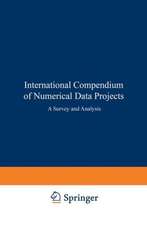Logics for Emerging Applications of Databases
Editat de Jan Chomicki, Ron van der Meyden, Gunter Saakeen Limba Engleză Paperback – oct 2012
This book provides a state-of-the-art overview of research on the application of logic-based methods to information systems, covering highly topical and emerging fields: XML programming and querying, intelligent agents, workflow modeling and verification, data integration, temporal and dynamic information, data mining, authorization, and security. It provides both scientists and graduate students with a wealth of material and references for their own research and education.
| Toate formatele și edițiile | Preț | Express |
|---|---|---|
| Paperback (1) | 649.93 lei 6-8 săpt. | |
| Springer Berlin, Heidelberg – oct 2012 | 649.93 lei 6-8 săpt. | |
| Hardback (1) | 654.87 lei 6-8 săpt. | |
| Springer Berlin, Heidelberg – 26 aug 2003 | 654.87 lei 6-8 săpt. |
Preț: 649.93 lei
Preț vechi: 812.42 lei
-20% Nou
Puncte Express: 975
Preț estimativ în valută:
124.38€ • 129.37$ • 102.68£
124.38€ • 129.37$ • 102.68£
Carte tipărită la comandă
Livrare economică 14-28 aprilie
Preluare comenzi: 021 569.72.76
Specificații
ISBN-13: 9783642622489
ISBN-10: 3642622488
Pagini: 388
Ilustrații: XV, 368 p.
Dimensiuni: 155 x 235 x 20 mm
Greutate: 0.54 kg
Ediția:Softcover reprint of the original 1st ed. 2004
Editura: Springer Berlin, Heidelberg
Colecția Springer
Locul publicării:Berlin, Heidelberg, Germany
ISBN-10: 3642622488
Pagini: 388
Ilustrații: XV, 368 p.
Dimensiuni: 155 x 235 x 20 mm
Greutate: 0.54 kg
Ediția:Softcover reprint of the original 1st ed. 2004
Editura: Springer Berlin, Heidelberg
Colecția Springer
Locul publicării:Berlin, Heidelberg, Germany
Public țintă
ResearchCuprins
1 XML: Model, Schemas, Types, Logics, and Queries.- 1.1 Introduction.- 1.2 XML Fundamentals.- 1.3 XML Schema Notations.- 1.4 Programming and Querying XML.- 1.5 The Theory of Regular Tree Languages.- 1.6 XML Query Languages versus Automata and Logic.- 1.7 Conclusion.- References.- 2 Query Answering in Inconsistent Databases.- 2.1 Introduction.- 2.2 Consistent Query Answers.- 2.3 Query Transformation.- 2.4 SpecifYing Database Repairs.- 2.5 Computational Complexity.- 2.6 Aggregation Queries.- 2.7 Related Work.- 2.8 Conclusions and Future Work.- References.- 3 Declarative Update Policies for Nonmonotonic Knowledge Bases.- 3.1 Introduction.- 3.2 Preliminaries.- 3.3 Framework and Language.- 3.4 Properties.- 3.5 Implementation and Update Agents.- 3.6 Extensions.- 3.7 Related Work.- 3.8 Conclusion.- References.- 4 Intelligent Agents: Issues and Logics.- 4.1 Introduction.- 4.2 Issues.- 4.3 Epistemic and Doxastic Logic.- 4.4 Desires and Intentions.- 4.5 Cohen and Levesque’s Logic of Intention.- 4.6 BDI Logic.- 4.7 KARO Logic.- 4.8 Logics for Multi-Agent Systems.- 4.9 Conclusion.- References and Further Readings.- 5 Logic Based Approaches to Workflow Modeling and Verification.- 5.1 Introduction.- 5.2 Preliminaries.- 5.3 Modeling Workflows with Temporal Logic.- 5.4 Modeling Workflows Using Event Algebra.- 5.5 Workflow Modeling Using Concurrent Transaction Logic.- 5.6 Other Uses of Logic in Workflow Modeling.- 5.7 Conclusion.- References.- 6 Logical Data Expiration.- 6.1 Introduction.- 6.2 Framework for Data Expiration.- 6.3 Administrative Approaches to Data Expiration.- 6.4 Query-Driven Approaches to Data Expiration.- 6.5 Potentially Infinite Histories.- 6.6 Related Work.- 6.7 Conclusion.- References.- 7 Description Logics for Modeling Dynamic Information.- 7.1 Introduction.- 7.2Conceptual Modeling of Dynamic Information.- 7.3 Description Logics.- 7.4 ERVT : A Formal Temporal Conceptual Model.- 7.5 An Object-Oriented Data Model for Evolving Schemas.- 7.6 Conclusion.- References.- 8 Logics for Authorizations and Security.- 8.1 Introduction.- 8.2 Preliminaries on Security Formalizations.- 8.3 Logic-Based Policy Specification Languages.- 8.4 Policy Evaluation and Verification.- 8.5 Other Applications of Logic to Security.- 8.6 Conclusion and Perspective.- References.- 9 Logical Languages for Data Mining.- 9.1 Introduction.- 9.2 The Search for Knowledge in Databases.- 9.3 Inductive Databases.- 9.4 Induction of Logic Programs.- 9.5 Multirelational Data Mining.- 9.6 A Vision of Convergence.- 9.7 Conclusion.- References.
Textul de pe ultima copertă
In this era of heterogeneous and distributed data sources, ranging from semistructured documents to knowledge about coordination processes or workflows, logic provides a rich set of tools and techniques with which to address the questions of how to represent, query and reason about complex data.
This book provides a state-of-the-art overview of research on the application of logic-based methods to information systems, covering highly topical and emerging fields covering XML programming and querying, intelligent agents, workflow modeling and verification, data integration, temporal and dynamic information, data mining, authorization, and security. It provides both scientists and graduate students with a wealth of material and references for their own research and education.
Caracteristici
Up to date snapshot of current research directions in the application of logic to data management and information systems Wide coverage of application areas including hot topics like XML modeling and queries, knowledge bases, intelligent agents, workflow, and data mining Only book with such a broad and in-depth coverage of logics applications in data mangement Includes supplementary material: sn.pub/extras
























